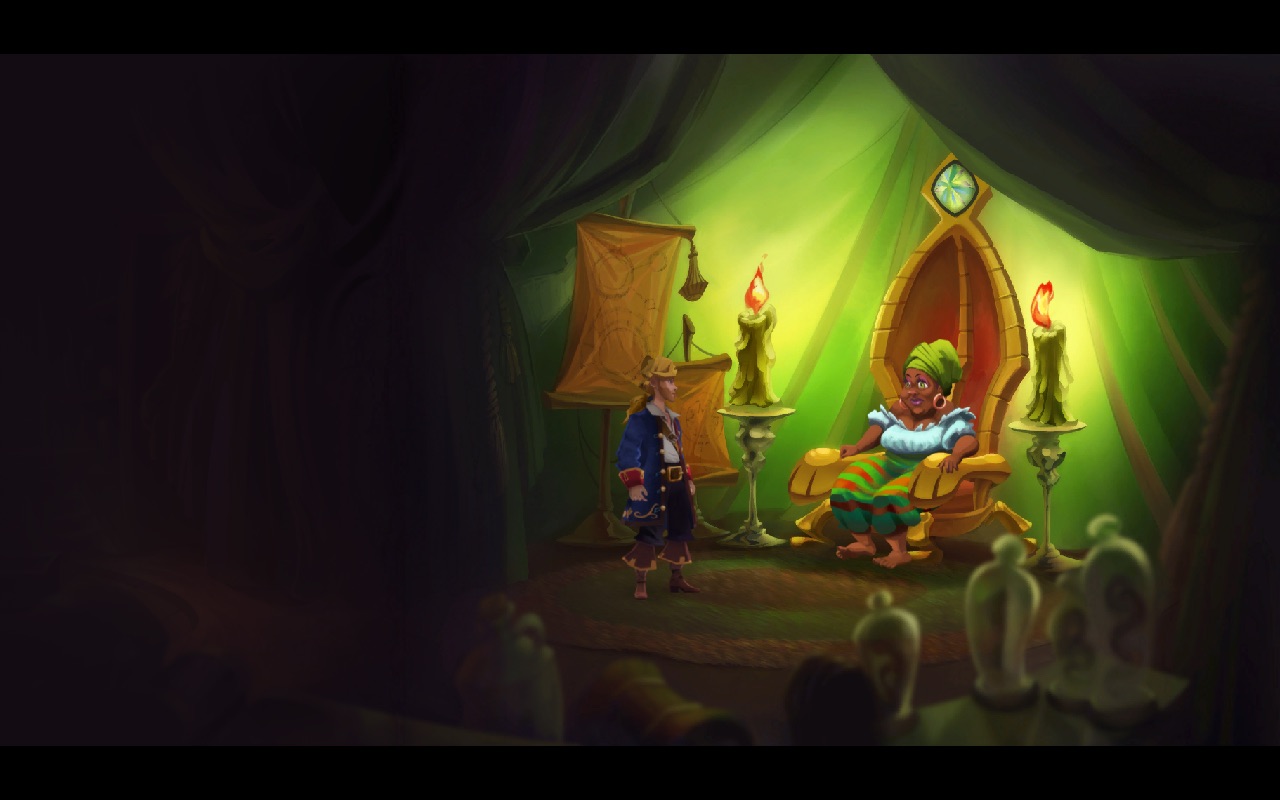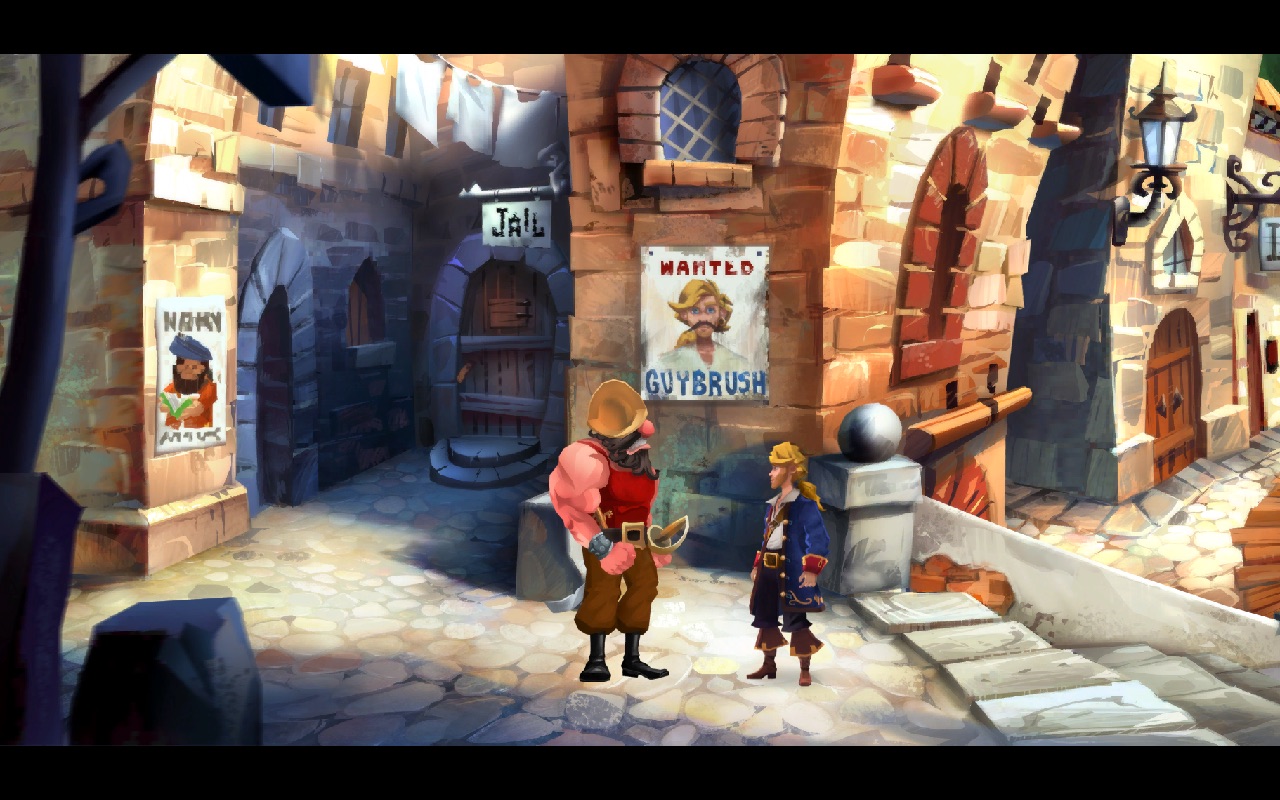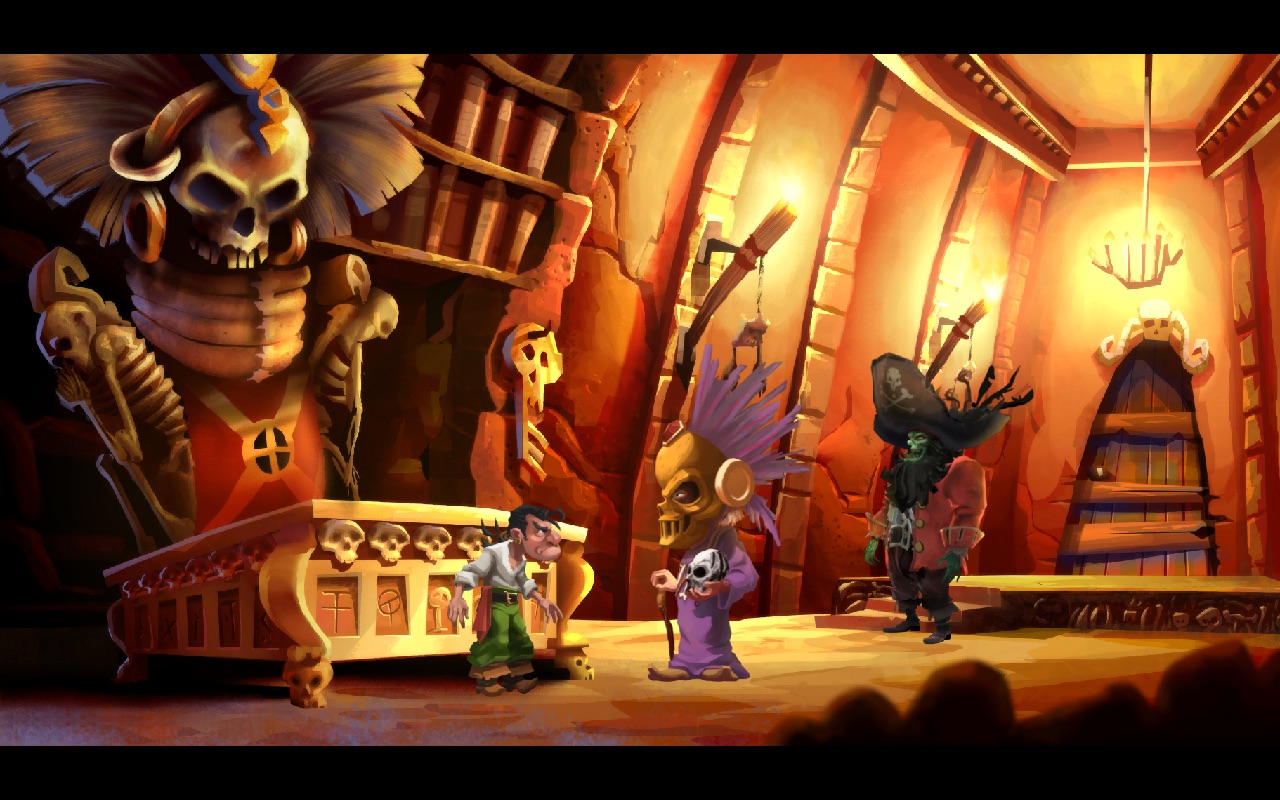I was ten years old when I first played Monkey Island 1 and it blew my mind. Granted, it does not take much to impress someone at that age: pirates, sharp writing, and a well-realised world is plenty.
A more mature and cynical eleven year old, on the other hand, is much harder to excite. It was therefore somewhat surprising to me at the time to have the belief I had experienced everything the world had to offer roundly shattered by the 1991 sequel, Monkey Island 2: LeChuck’s Revenge.
Warning: spoilers
Entering Woodtick for the first time and seeing a thriving town constructed of decommissioned boats was a jaw-dropping display of creativity and imagination.

And, in the same way that this eleven year old was more sophisticated, Guybrush too had matured. Where once was a wannabe pirate, there now stood this experienced swashbuckler in a long blue jacket, fancy pants, and impressive boots.
But that was twenty-five years ago. When you’re at an impressionable age it’s very easy to leave an impression so, as an even more mature and definitely more cynical thirty-six year old, I can hopefully move beyond “wow, funny pirates!” and begin to uncover a more fundamental understanding of what made this one of my most cherished game series.
Abstract
In my post about Monkey Island, I focused primarily on the storytelling. MI2 follows the same narrative formula as it’s predecessor: You are stuck on an island, there are some tasks you need to perform to get off that island, then you have to go defeat LeChuck.
Character motivations, both big (find the legendary treasure of Big Whoop) and small (get of Scabb Island) remain clear and, crucially, well presented to the player (you are repeatedly told what you need to do by basically every character you talk to). We have our initial, local antagonist stopping us, and we have our overarching villain in the background pulling all the strings. The writing remains as sharp as ever, especially when compared to its rivals at the time whose stories have not aged as well.
Instead of looking exclusively at the importance of having a solid narrative again (even if this game does one has one of my favourite, and most controversial, twists in a video game) what I am more interested in this time is a broader look at the game design in relation to it. Specifically, how the shifting edges of the world and the puzzles therein couple tightly with the story and how they reinforce one another.
I’d rather be a pirate on Scabb…

Quest for Glory IV, Freddy Pharkas, and Simon the Sorcerer (all released around the same time) give you access to almost the entire game area from the very start, making the possibility space intimidatingly large.
LucasArts adventures, on the other hand, use the expanding and contracting of the game world as a reward for solving a series of puzzles, a way to control this space, and as a way to control both plot and pacing.
The balance between restricting the player while making the world believable remains a perennial design challenge even to this day and LucasArts tying this to the plots of their stories was key to striking this balance.
In Monkey Island 2, we have our local antagonist Largo who is preventing you from leaving the first island with his embargo. This simple fact not only provides a believable reason why the puzzle space is kept small, but also serves as the inciting incident that gets the action going.
As I work through this history of adventure games, there was a tension around this time between the open world, RPG-style game and the much more tightly controlled, story-focused, and plot-driven style.
It was the story-driven games that came to define the genre and a big part of that was down to LucasArts’ incredible writing talent. It’s clear now just how much value and work they put into the writing and how it affected many of their design decisions.
The Road of Trails

Our initial quest to get rid of Largo echoes the Three Trials of the first game. The quest involves collecting the ingredients for a voodoo doll, a foreshadow of the skills you’ll need to defeat LeChuck in the endgame. Using puzzles like this—as a plot device where lessons learned earlier are required later in remixed form—borrows heavily from traditional storytelling and is an effective way to create a more holistic experience (see also: the spitting straw).
The four necessary ingredients to the voodoo doll also illustrates another adventure game design trope: multiple parallel puzzle paths. Other games attempt this with varying degrees of success (in Simon the Sorcerer, for example, there are far too many paths to follow at once whereas in Space Quest IV there tends to only be a single path) but, when done effectively, this kind of branching gives the feeling of choice and player autonomy in what is in reality a restricted space.
In MI2, these puzzles are also not pointless roadblocks bearing no relation to the ultimate goal of the protagonist, but become essential skills that are required to win the day and, while the voodoo doll recipe (and almost any puzzle in an adventure game) is a MacGuffin, it is, importantly, also consistent with the world it inhabits.
The most egregious counterpoint that I’m still mad about is the Energizer Bunny in Space Quest IV that is just randomly hopping around this post-apocalyptic landscape. Making this joke at the expense of any kind of narrative consistency was not worth it to me—ideally, jokes should emerge from the story and characters—and served instead to take me out of the otherwise ominous, Blade Runner-esque world they had dropped me in.
With decades of hindsight, story-driven puzzle design is obvious to modern eyes (even if it’s not always effectively implemented), but there are plenty of examples in other games of the era of contextless puzzles. Like antagonists in traditional narratives, the puzzles in LucasArts’ adventures tend to be tightly coupled to the goals and motivations of the character. Completion of them therefore feels less like coming out of a frustratingly arbitrary side road and more like an essential device to propel the plot forward.
Make Like a Tree and Get Out of Here

It’s a small thing, but rarely do our actions result in a linear chain of events. Having solutions to puzzles have multiple side effects acknowledges this and helps prevent the puzzle-solving from feeling like you are overcoming challenges in a step-by-step fashion.
Cutting the alligator’s rope early on in this game opens up two new branches: it gives you access to Largo’s room and it gives you an item needed to create the trap for the rat. This kind of branching must necessarily be limited by exponentially increasing complexity, but using it where possible is a subtle thing that makes the world feel that little bit more real.
I’d Rather Leave Than Suffer This
It’s not all sunshine and flowers, though. Some of the puzzles do require logical leaps or specialised lateral thinking that are more frustrating than funny. The monkey wrench puzzle is one such example—relying on colloquial terms (a monkey wrench is known as a gas grip in the UK, or sometimes just a spanner) while trying to appeal to international audiences is a sure fire way to leave a significant portion of them feeling cheated.
It’s impossible to know what we don’t know, of course, but one modern solution to this pitfall would be to get feedback from international playtesters as early as possible (something that was probably prohibitively expensive in 1991).
Now I Am The Master

The final act in an adventure game is a difficult design challenge and many other games (even other Lucasarts titles such as Full Throttle) fall into the trap of using death as a punishment for failing to find the correct solution in time.
This works in terms of creating the necessary drama for a suspenseful conclusion, but at the expense of narrative cohesion. If the character has been unable to die through the proceeding game, then suddenly making them vulnerable feels like a cheap trick.
In MI2, however, LeChuck can’t kill you. He can repeatedly frustrate your efforts to both figure out what you need to do and to lay your traps, and this is enough to raise the stakes and create a worthy final act. It strikes the perfect balance between being a tense encounter and remembering that it is an adventure game and not a skill-based action game.
The callback to the first quest is a what sets this apart, though. Remembering the recipe and figuring out how to gather the ingredients on the fly really makes you feel like you’ve gone from being the pupil to becoming the master and ties the story together nicely (until you hit the controversial epilogue, of course).
…Than a Scab on a Pirate
The first two Monkey Island games are masterclasses in adventure game design. Immersive without being wordy, challenging without feeling arbitrary, and equal parts funny and clever, they remain stunning examples of the genre and (unusually for something so near to George Lucas) the Special Editions of both titles update what needed to be updated in a way that enhances the core of what makes these games so great without overshadowing them.
Major Lesson: The puzzles serve at the pleasure of the parable
P.S. To my eleven-year-old self: With these pseudo-academic objective observations, I have now retrospectively justified your passionate life-long obsession with this game. You’re welcome.
